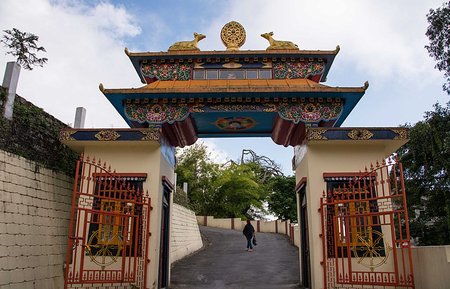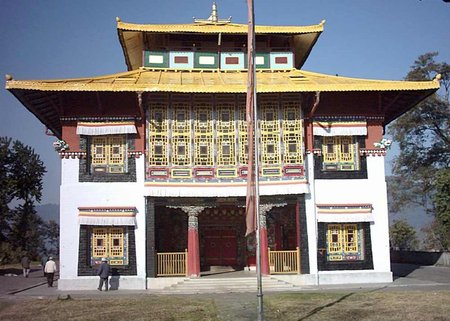Tsuklakhang Palace and Monastery, Gangtok
At one end of
The Ridge in Gangtok is the Tsuklakhang Palace and Monastery that was built for the royal family of Sikkim in 1898 when Gangtok became the capital of Sikkim. Sikkim was then a separate country of its own and was ruled under the monarchy of King Thutob Namgyal who was the 9th Chogyal (i.e the king) of Namgyal dynasty.
At the entrance to the palace is a huge impressive gate built in Tibetan style with a pagoda like top. A pathway leads inside to the monastery and the palace. The place compound is fringed with coniferous trees which guard the views of the two buildings inside - one is the Tsuklakhang Monastery, a place of worship which was used by the royal family for prayers and occasions like coronation, victory ceremonies, births, deaths, marriages etc. The other building is the Royal Palace.
Entrance gate of Royal Palace and Monastery
Photo: Wikimedia Commons
There are large number of Buddhist religious scriptures and books that are stored inside the monastery. There are altars with paintings of various deities including Buddha. Since this monastery was used exclusively by the royal family, a separate one -
Enchey Monastery was later built nearby so that the common people too could offer prayers.
The palace building looks more like a bungalow and surrounded by flower gardens. Although quite big, but it doesn't look as mammoth and awe-inspiring as a usual royal palace.
Tsuklakhang Monastery, Gangtok
Photo: Wikimedia Commons
Soon after the palace, there is a steep descent. Far below, the river Roro Chu flows through a valley (the word 'chu' in Nepali means a stream). Roro Chu finally merges into the river Ranikhola at Ranipool, which in turn merges into river Teesta at Singtam.
If you walk down the main road (i.e. the Secretariat Road), soon you will reach the Secretariat building known as 'Tashiling Secretariat' which is the center of Sikkim's administration.
Tsuklakhang Palace and its Royal History
King Thutob Namgyal and his queen Yeshe Dolma were the first residents of this palace. Dolma was born to an elite family in Tibet and became the second queen when the king Thutob remarried in 1882 after his first wife passed away. Their marriage took place in Lhasa of Tibet.
Although the king agreed to remarry, strangely he did not initially accept the second queen as his wife and she kept living in Chumbi of Tibet. She was not only a beautiful lady, she was also a very learned and an intelligent woman. After 4 years when the king again visited Chumbi and met her, he became so impressed with her beauty and wisdom that he finally accepted her as his wife.
The British became suspicious that it was under the influence of the queen that the king started ignoring the British governance and began to align Sikkim with Tibet in 1886. Soon the king was made powerless by the British. This was when the king and the queen tried to flee to Tibet through Nepal, but they were intercepted and put under house arrest in Darjeeling area.
During their one year of house arrest in Kurseong, the king realized that they had no option but to cooperate with the British, and eventually they did so and rebuilt their friendship with the British.
The queen Dolma had a deep knowledge in Tibetan language and literature. She had great wisdom on Buddhism and Buddhist philosophy as well. She was the first who wrote Sikkim's history in Tibetan language which was later translated into English. Sir John Claude White, who was then running Sikkim's administration, mentioned that if the queen was born in Europe instead of in Tibet, she would have left her deep mark in history.
Claude White left Sikkim in 1908, the queen Yeshe Dolma passed away in 1910 and the king Thutob Namgyal died in 1914. Thutob's second son, Sidkeong Tulku Namgyal, who was groomed by the British, took over the reigns following his father's death, but died only after 10 months. In 1915, Tashi Namgyal, who was the other son of Thutob, became the king.
Tashi Namgyal was born in Kurseong when his parents were practically under house arrest there. He did his studies in Darjeeling's St. Paul's School and Mayo College Boarding School in Ajmer. He became a king at the age of 22. The first World War had started then. The British had no time to focus on Sikkim's administration and therefore the entire administrative authority of Sikkim was returned to the king. The peaceful reign under Tashi Namgyal continued through 1930s.
But, then king's personal life started to come under a lot of turmoil and pain. The queen left him and started to live in a palace outside Gangtok. His eldest son and the royal heir Paljor Namgyal had joined the Indian Air Force and died in a plane accident in 1941.
The devastated king gave up all his royal duties. He started to spend most of his time sitting at the veranda at the northern side of the palace and painting pictures of the nature.
Traditionally in Sikkim, the second son of the family would become a lama. Accordingly, the second son Palden Thondup was sent to the Pemayangtse Monastery near Pelling to become a lama. However, he was brought back due to such situation and virtually all royal duties were handed over to him, although Tashi Namgyal remained as the king. Palden Thondup did his schooling in St. Pauls School in Darjeeling and Bishop Cotton School in Shimla.
In 1947, the British left India, and that year the Nepalese community that were the majority in Sikkim, formed a political party and in 1949 they decided to make an officer representative from Government of India to be the head (i.e. Prime Minister) of Sikkim. So the officer arrived and started living in a building called 'Mintokgang' located next to
the Ridge. The building is now the official residence of the Chief Minister of Sikkim.
Palden Thondup Namgyal was coronated as the king in 1965 after his father died. After his first wife died, he married Hope Cooke, an American socialite in 1963. The Indian Government was always suspicious of his political activities and thought he was causing an internal rebellion and trying to retain Sikkim as an independent country to be ruled under his monarchy. And this became quite apparent when his wife Hope Cooke published an article stating that India had made unauthorized possession of several Sikkmese properties.
In 1975, the Prime Minister of Sikkim appealed to the Indian Parliament to make Sikkim a state of India. Soon in the same year, the Indian army took over Gangtok, deposed the king and abolished the monarchy. From an independent country, Sikkim became the 22nd state of India in 1975.
So, Palden Thondup Namgyal was the 12th and the last king of Sikkim who lived in Tsuklakhang Royal Palace. He divorced Hope Cooke in 1980 and died on 29 January 1982, at the age of 58.
How to reach
The Tsuklakhang Palace and Monastery is located at one end of The Ridge. You can walk to this place from the town center (takes about 20-25 minutes). Alternatively, you can take a local taxi which should take 10-12 minutes from the town center. There is no admission fee.
Related Articles
|
Visitors' Reviews/Comments
|

